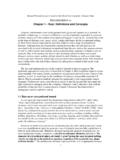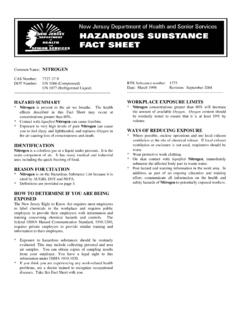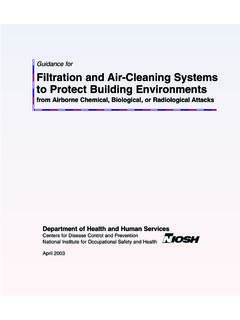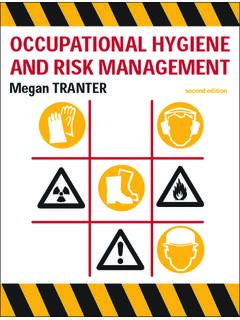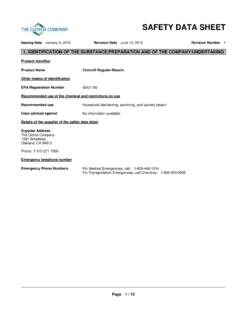Transcription of Indoor Air Quality - Occupational Safety and Health ...
1 Indoor Air Quality in Commercial and Institutional BuildingsOSHA 3430-04 2011 Occupational Safety and Health Act of 1970 To assure safe and healthful working conditions for working men and women; by authorizing enforcement of the standards developed under the Act; by assisting and encouraging the States in their efforts to assure safe and healthful working conditions; by providing for research, information, education, and training in the field of Occupational Safety and Health . This publication provides a general overview of a particular standards-related topic. This publication does not alter or determine compliance responsibili-ties which are set forth in OSHA standards, and the Occupational Safety and Health Act of 1970. More-over, because interpretations and enforcement poli-cy may change over time, for additional guidance on OSHA compliance requirements, the reader should consult current administrative interpretations and decisions by the Occupational Safety and Health Review Commission and the contained in this publication is in the public domain and may be reproduced, fully or partially, without permission.
2 Source credit is requested but not information will be made available to sensory- impaired individuals upon request. Voice phone: (202) 693-1999; teletypewriter (TTY) number: 1-877-889-5627. Indoor Air Quality in Commercial and Institutional Buildings Occupational Safety and Health Department of LaborOSHA 3430-04 2011 The guidance is advisory in nature and informational in content. It is not a standard or regulation, and it neither creates new legal obligations nor alters existing obligations created by OSHA standards or the Occupational Safety and Health Act. Pursuant to the OSH Act, employers must comply with Safety and Health standards and regulations issued and enforced by either OSHA or by an OSHA- approved State Plan. In addition, the Act s General Duty Clause, Section 5(a)(1), requires employers to provide their workers with a workplace free from recognized hazards likely to cause death or serious physical harm.
3 Occupational Safety and Health Administration2 ContentsIntroduction 3 Background 3 Benefits of Mitigation of IAQ Problems 4 Health Effects 4 Sources of Indoor Air Pollutants 5 Common Pollutant Categories 6 Prevention or Control IAQ Problems 6 IAQ Management Approach 6 Identification and Assessment 7 Control Methods 7 Seeking Professional Assistance 8 Applicable Standards and Regulations 9 OSHA Standards 9 Standard Interpretations 9 State Programs 10 National Consensus Standards 10 OSHA Assistance, Servicesand Programs 11 Appendix A: Common Indoor Air Contaminants 16 Appendix B: Steps to Improve Indoor Air Quality 19 Appendix C: HVAC System Maintenance Checklist 20 Appendix D: Investigating IAQ Problems and Complaints 21 Appendix E: Selected Resources 22 Hazard Recognition 22 Evaluation and Control 23 Appendix F: OSHA-Sponsored environmental Tobacco Smoke Workshops 25 Workshops I - III 25 References 26 Indoor AIR Quality IN COMMERCIAL AND INSTITUTIONAL BUILDINGS3 IntroductionIndoor air Quality (IAQ) is a major concern to businesses, schools, building managers, tenants, and workers because it can impact the Health , comfort, well-being, and productivity of the building occupants.
4 OSHA recognizes that poor IAQ can be hazardous to workers Health and that it is in the best interest of everyone that building owners, managers, and employers take a proactive approach to address IAQ concerns. This OSHA guidance document on IAQ provides practical recommendations that will help prevent or minimize IAQ problems in commercial and institutional buildings, and help resolve such problems quickly if they do arise. It provides flexible guidance to employers to help them keep their build-ings free of pollutants or conditions that lead to poor IAQ. It also provides information on good IAQ management, including control of airborne pollutants, introduction and distribution of adequate make-up air, and maintenance of an acceptable temperature and relative humidity.
5 Temperature and humidity are important because thermal comfort underlies many complaints about poor air Quality . Some of the information presented here has been derived from the environmental Protection Agency s (EPA) report, An Office Building Occupant s Guide to IAQ (1)1 and other documents listed in Appendix E, Selected Resources. The issue of environmental tobacco smoke will only be addressed in Appendix F, or indirectly in discussions of air Quality relative to some possible components of tobacco smoke, , carbon monoxide, carbon dioxide, particulates, etc. In 1998, OSHA conducted a series of three workshops on this issue and the proceedings of these work-shops were published in 1999. See Appendix F for more document is directed primarily at employers, building owners and managers, and others responsible for building maintenance, but may also be used as a basic reference for all those involved in IAQ issues.
6 Furthermore, information present-ed here can help with the decision of whether or not the services of an outside professional may be needed. The advice of a medical professional should always be sought if there are any immediate Health issues. Contractors and other professionals ( , industrial hygienists or other environmental Health and Safety professionals) who respond to IAQ concerns, as well as members of the general public, may also find this information has been identified by the EPA as one of the top five most urgent environmental risks to public Health (2). The Centers for Disease Control and Prevention (CDC) estimates that the majority of Americans spend approximately 90 percent of their time indoors (3). On average, office workers spend approximately 40 hours a week in office buildings.
7 These workers also study, eat, drink, and, in cer-tain work settings, sleep in enclosed environments where make-up air ( , fresh air added to re- circulated air) may be compromised. For this reason, some experts believe that more people may suffer from the effects of Indoor air pollution than from outdoor air building has its own set of circumstances. Air Quality may be determined by the site of the building, its original design, renovations, whether air handling systems have been maintained, occupant densities, activities conducted within the building, and the occupants satisfaction with their environment. IAQ problems can arise from a single source or any combination of factors. Inadequate IAQ may begin with poor building design or failure of the building enclosure or envelope (roof, facade, foundation, etc.)
8 Other issues may be associated with the location of the building and mixed uses of the building. Many common IAQ problems are associated with improperly operated and maintained heating, ventilating and air-conditioning (HVAC) systems, overcrowding, radon, moisture incursion and dampness, presence of outside air pollutants, and the presence of internally generated contami-nants such as use of cleaning and disinfecting supplies and aerosol products, off-gassing from materials in the building, and use of mechanical equipment. Improper temperature and relative humidity conditions can also present problems, especially concerning IAQ complaints are associated with flaws in building design and by inadequate routine preventive maintenance of building enclosures (envelopes), plumbing, and HVAC systems (2, 4, 5).
9 To resolve many IAQ problems, a preventive main-tenance program should be established based on the system s recommended maintenance schedule outlined by the architect or engineer, the manufac-turer, or an HVAC professional. Regular preventive maintenance not only ensures that systems are operating properly, but also can result in cost savings, improved operating efficiency, and increased worker productivity (6). The Green 1 The numbers in parentheses refer to specific entries in the last section of this document titled References. Occupational Safety and Health Administration4 Research has linked building dampness with significant Health effects. Numerous species of bacteria and fungi, in particular filamentous fungi (mold), can contribute significantly to Indoor air pollution (4, 15-20).
10 Whenever sufficient moisture is present within workplaces, these microbes can grow and affect the Health of workers in several ways. Workers may develop respiratory symptoms, allergies, or asthma (8). Asthma, cough, wheezing, shortness of breath, sinus congestion, sneezing, nasal congestion, and sinusitis have all been associated with Indoor dampness in numerous studies (21-23). Asthma is both caused by and worsened by dampness in buildings. The most effective means to prevent or minimize adverse Health effects is to determine the sources of persistent dampness in the workplace and elimi-nate them. More details on preventing mold-related problems can be found in the OSHA publication titled: Preventing Mold-Related Problems in the Indoor Workplace (17).











